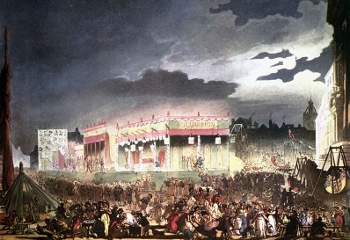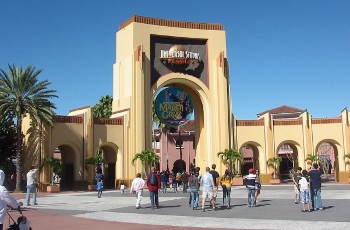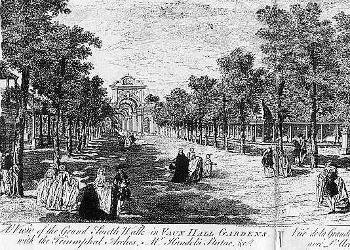I first wrote a version of this blog in 2011 when I’d just purchased a new research book, Vauxhall Gardens: A History by David Coke and Alan Borg, a coffee-table sized volume brimming with everything you’d want to know about these historical pleasure gardens. It was worth every penny I spend on it and I spent a lot of pennies!
During this pandemic year, though, I came across a lecture on Vauxhall that gave some new information. More on that later.
I think of Vauxhall Gardens as the Disneyland of its time, a place people of all walks of life and social classes flocked to for recreation, to see wonders that thrill, amaze, or simply entertain them. Things like fireworks and tightrope walkers, musical performances, frescos made so real you felt transported to a different land, spooky dark walks featuring a hermit at the end. There was food special to the place, just like the special foods we find at amusement parks or State Fairs. Paper-thin slices of ham, tiny whole chickens, orgeat (the soft drink of the day), poor quality wines, cider and ale.

Jonathan Tyers opened Vauxhall Gardens in 1729 and from the first made no distinctions between the classes. Everyone paid the same price of admission, so from the first, the classes mixed in the various entertainments like a Venetian Carnival. Throughout the years Vauxhall Gardens entertained visitors with music, a mix of performances from serious styles of music to light-hearted popular tunes of the day. A grand organ was included. Popular vocalists appeared. Handel was featured. In fact–new information–Handel’s Fire Music was first played at Vauxhall. Music was often advertised as coming first to Vauxhall, a way to increase attendance.
Artwork was always a part of the gardens, including paintings by Hogarth and sculpture. A statue of Handel came to personify Vauxhall and remained in the gardens most of its almost 200 years.
Other entertainments appeared, some from the beginning and some as years went on. Fireworks. Fountains. Lamps which were lit all at once. A rope dancer named Madame Saqui. I once mentioned Madame Saqui in one of my books and received a letter from a reader in the UK whose last name was Saqui. She’d not known of this possible ancestor until reading of her in my book.
Some more new information from the lecture–the servants Tyers hired to serve the food were highly trained to be as unobtrusive as possible. Like Disneyland employees? Also unobtrusive (and new information to me) were guards who patrolled the Dark Walk and also snatched up drunk young men and put them in a cage to sober up. Wouldn’t one of these guards be a good character for one of our Regency books?
Speaking of possible Regency characters, the lecture also revealed that the casual pick-ups at Vauxhall were not typically the prostitutes, but other young women looking for that sort of good time. The nearby inns and taverns provided the rooms for such goings on.
Although entry cost a shilling, policing legitimate attendees was a challenge. Some gained entry through counterfeit tokens; others by climbing in from the riverbank. Tyers built a haha as a barrier, but this did not stop the most intrepid trespassers.
I’ve loved using Vauxhall Gardens as a setting in my books. Flynn, my hero in Innocence and Impropriety became smitten with Rose as she sang at Vauxhall Gardens. In A Reputable Rake, Morgana brought her courtesan students to Vauxhall Gardens to practice their lessons. A masked Graham Veall chose Vauxhall Gardens as a place to meet Margaret and hire her as a temporary mistress in my homage to Phantom of the Opera, The Unlacing of Miss Leigh.
I also used Vauxhall Gardens for A Not So Respectable Gentleman?, the last of the Welbourne Manor books. That book was set in 1828 and my wonderful research book told of several new events at Vauxhall that year.
New was the Grand Hydropyric Exhibition, consisting of cascades of colored fire and water. A new vaudeville called The Statue Lover was introduced, as well as a short comic ballet called The Carnival of Venice. Even though there had been complaints of excessive noise the previous year, a reenactment of the Battle of Waterloo took place on the battle’s anniversary. They also introduced a lottery with dozens of different prizes.
Are you planning any summer outings? It may take us all a while to feel comfortable in the sort of crowded summer settings like Vauxhall, I think. No matter what, this summer is bound to offer more entertainments than last summer!
Let’s look forward to it!







